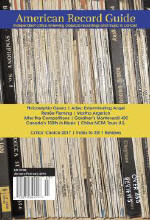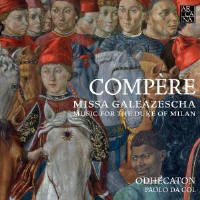Texte paru dans: / Appeared in: |
|
|
Outil de traduction ~ (Très approximatif) |
|
|
Reviewer: Catherine
Moore
This excellent program uses a
set of “motetti missales” by Loyset Compere (c 1445-1518) as the centerpiece
for an exploration of the musical wealth associated with the Duke of Milan.
Music by four other composers—Agricola, Lubeck, Martini, and Weerbecke—alternates
with eight liturgical motets by Compere, each “in place of” one section of
the Mass: Introit, Gloria, Credo, Offertory, Sanctus, Elevation, Agnus Dei,
and Deo Gratias. There is no setting of the Mass texts themselves because
“these [motetti missales] cycles were performed during the mass and
represented a sort of sonic accompaniment to the liturgical action”. It is a
credit to the high reputation of Paolo Da Col, leader of the vocal ensemble
Odhecaton, that he is joined here by three top instrumental ensembles and
leading organist Liuwe Tamminga. Tempos are perfectly judged, the balance of
voices and instruments allows all to be heard and the polyphonic lines to
dovetail gently together to beautiful effect. Human and instrumental
“voices” join together, by turns stately, noble, reverent, and tender. A
wide variety of timbres is judiciously, precisely, and effectively deployed,
whether the reeds and brass of La Pifarescha or the vielles, harp, lute, and
cornetto of La Reverdie. Fanfare-like short sonatas by Lubeck, played by the
six trumpets and timpani of Pian&Forte, fittingly open and close the
program. Striking examples of touching beauty abound, such as delicate harp
interwoven with vielles in the instrumental version of Agricola’s ‘Homme
Banni’, followed by ‘Salve, Mater Salvatoris’ where singers are joined by
shawms and trombones. Four of the motets (some 18 minutes in total) are
beautifully played by Tamminga, performing on the “old” (1475) organ at San
Petronio Basilica in Bologna. I always smile when I hear organists refer to
the “new” organ there: it’s from 1596! Two fine booklet essays tell about
the music and the cultural environment where was created and performed. I’m
always happy to see short bios of booklet-note writers—in this case Agnese
Pavanello and Daniele V Filippi—who both work at the Schola Cantorum
Basiliensis. Their observation that, “like many important composers of the
late 15th Century, Loyset Compere has long remained, for the modern
audience, eclipsed in the shadow of Josquin des Prez”, makes us all the more
appreciative of the value of this release. Notes, texts, translations. To
further explore recordings by Odhecaton, I recommend Gesualdo’s Sacrarum
Cantionum (Ricer 343, N/D 2014).
| |
|
Support us financially by purchasing this disc from eiher one of these
suppliers. Un achat via l'un ou l'autre des fournisseurs proposés contribue à défrayer les coûts d'exploitation |
|
|
|
|
|
Cliquez l'un ou l'autre
bouton pour découvrir bien d'autres critiques de CD |
|




